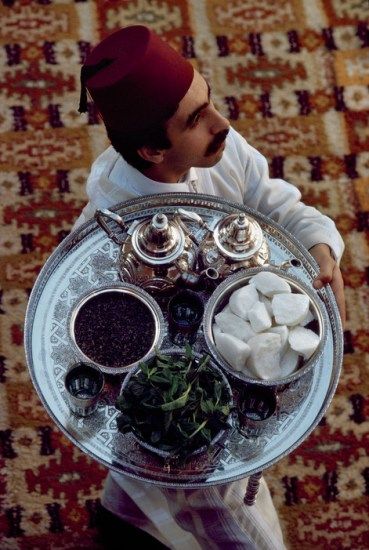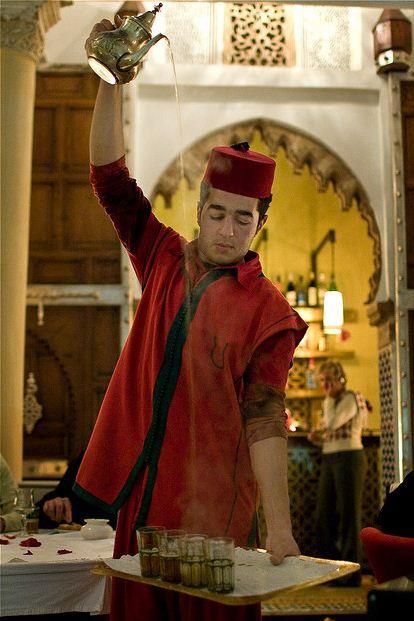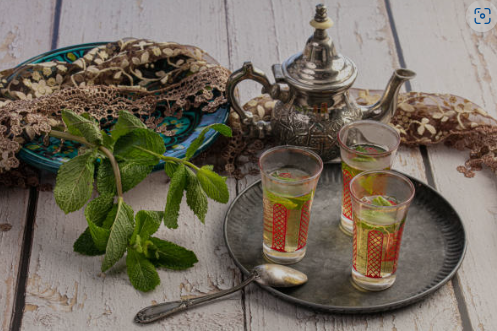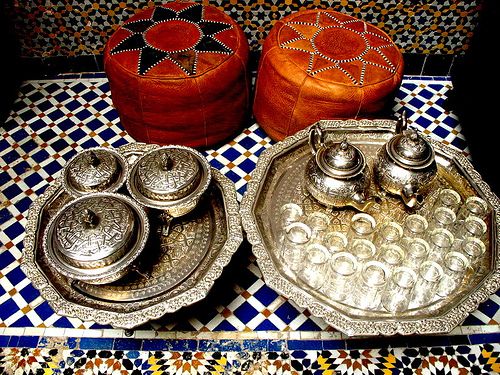
A Symbol of Moroccan Culture and Warmth
In Morocco, offering a glass of Atay b N3na3 (mint tea) is more than a tradition; it’s a cultural ritual, a gesture of welcome, and an invitation to connect. Whether you’re visiting a friend’s home, a shop in the souk, or a remote desert camp, you’re almost guaranteed to be offered a steaming glass of sweet, fragrant mint tea. But this iconic drink is much more than just a refreshment — it’s the heartbeat of Moroccan hospitality.

The Origins and Cultural Significance of Atay
Mint tea, or “Atay” as it’s commonly called, became popular in Morocco during the 18th century, likely introduced through trade with the British and Portuguese. However, Moroccans quickly made it their own by infusing it with fresh spearmint leaves (n3na3) and generous amounts of sugar, crafting a drink that is both soothing and invigorating.
In Moroccan households, preparing Atay is often a ceremonial act. The tea is poured from a height to create a light froth, believed to improve both the texture and flavor. Sharing tea isn’t just a casual affair — it marks moments of family unity, business discussions, celebrations, and quiet reflection.

What Makes Moroccan Mint Tea Unique?
Several elements distinguish Atay b N3na3 from other mint teas around the world:
- Gunpowder green tea: This rolled tea has a strong base flavor that pairs well with mint and sugar.
- Fresh mint: Only fresh mint — ideally Moroccan spearmint — delivers that bold, cooling punch.
- Sugar: Moroccan tea is famously sweet. The sugar isn’t just a flavor enhancer; it’s an essential element of the experience.
- Ceremonial preparation: It’s not uncommon for the host to prepare and serve the tea in an elaborate fashion, pouring it from a silver teapot into small decorated glasses.
The Traditional Recipe: How to Make Atay Like a Local
Ingredients:
- 1 tablespoon of Chinese gunpowder green tea
- A large handful of fresh mint (n3na3)
- 4–6 teaspoons of sugar (adjust to taste)
- 1 liter of boiling water
Instructions:
- Rinse the green tea leaves with a little boiling water to remove bitterness.
- Add the rinsed tea back to the teapot with fresh boiling water.
- Let it steep for a few minutes, then add the mint leaves and sugar.
- Stir well or pour into a glass and back into the pot to mix.
- Pour from a height into small glasses to create a frothy top.
The result? A perfect balance of bitter, sweet, and herbal — a sensory trip to the medina with every sip.
More Than Just a Drink: Atay in Moroccan Daily Life
You’ll find Atay b N3na3 everywhere — at breakfast tables, during family gatherings, in street cafés, and even at high-end riads. In the countryside, it’s a key part of hospitality rituals. A guest refusing tea is practically unheard of.
In business, serving tea often precedes negotiations or contract discussions. In social gatherings, it opens conversations and deepens connections.
Health Benefits of Moroccan Mint Tea
Beyond its cultural symbolism, Atay offers real health benefits:
- Aids digestion: Especially after heavy meals.
- Soothes stress: The aroma of mint is naturally calming.
- Boosts immunity: Thanks to the antioxidants in green tea and mint.
So not only does Atay warm your heart, but it also supports your well-being.
A Living Tradition in a Modern World
Despite the rapid modernization of Moroccan cities and lifestyles, Atay remains sacred. Even among the younger generation, the act of making and drinking tea is deeply rooted. Today, many cafés and restaurants offer fusion versions, but the classic will always reign supreme.
For travelers, learning how to make Moroccan mint tea is often one of the most cherished experiences. Workshops, cooking classes, and even Airbnb experiences now include tea preparation as part of cultural immersion.
Final Sip: Why Atay b N3na3 Is Morocco in a Glass
Every cup of Atay b N3na3 tells a story — of warmth, family, patience, and Moroccan soul. It brings people together, honors guests, and captures the spirit of a country that values tradition, connection, and generosity.
So next time you take a sip of this golden-green nectar, remember: you’re not just drinking tea — you’re taking part in a legacy of flavor, culture, and hospitality that has charmed hearts for centuries.
Whether you’re planning a trip to Morocco or just want to bring a piece of it into your kitchen, mastering the art of Atay is one of the most beautiful ways to connect with its soul.

